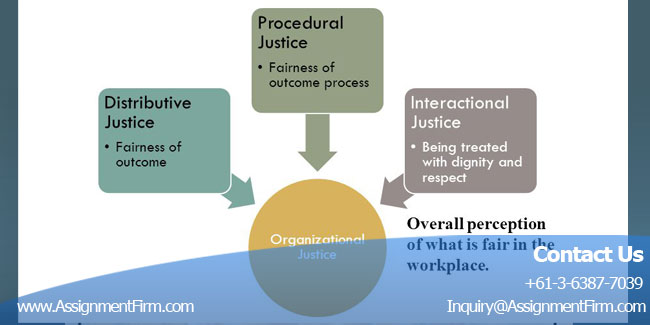Discuss how organizational justice aspects can impact on job satisfaction of employees and their organizational citizenship behaviour
Answer: Introduction
The purpose of catering information about the organizational justice which is an important workplace concept. Here, the paper has highlighted the various aspects of ororganisationalustice such as distributive, procedural and interactional and how these aspects can impact the job satisfaction of employees and also their behaviour in terms of organisational behaviour.

2. Organizational Justice
Organizational Justice is the word used for describing the various types of problems and issues faced by the employees of an organization which they term as injustice. This terminology focused on the fact that how an employee can judges the behavior of the organization and the employee’s resulting attitude and behavior (Baligh, 2009). For example, if a particular organization removes some employees without any proper cause, the other remaining employees might feel a sense of injustice which might result in the change in their attitude this would result in the drop of productivity. These viewpoints can make an impact on the attitudes and behavior of the employees which can be either for good or bad side and this makes a positive or negative impact on the performance of the employees and along with it affects the functionality and success of the organization. The theory behind of the term “organizational justice” goes beyond the long-established models of work related behavior that makes the concepts of demand, control and social support in terms of job being the main factors which helps in determining the wellbeing and also the extent of productivity of an individual (Dent, 2009). The idea of being biased is an elaborated concept in terms of organizational justice and this would comprise of more of the elements of the social structure according to which these characteristics operate. At times, the idea or concept of organizational justice will only be visible and appropriate when there is any occurrence of violation of justice takes place.
Few examples of the prevalent injustices in many the organizations would be unequal pay for the men and women in terms of the same kind of job, performance review being done by someone whom the employees know a little about, the implementation of personality inventories in terms of selection of new staff and dismissal of the employees in an unpredictable manner (Fellenz and Martin, 2010). For these and other various injustices prevalent in an organization, work psychologists have highlighted three distinct types of organizational justice, namely distributive, procedural and interactional.
2.1 Distributive Justice
The concept of distributive justice defines the results of being able to distribute the inputs of an organization proportionally as per the principle of equity. The results of a particular job may take the figure of issues related to wages, security of the job, opportunities for the promotion and career enhancement, whereas the inputs in an organization would comprise of education, training, experienced assignment expert and effort. Since at times it cannot be possible for determining as to what comprises related to an accurate level of delivering remunerations in terms of a particular degree of input, the employees often tend to make a judgment in relative terms, trying to look forth for a relation between contribution and outcome which is similar to that of their subordinates or colleagues. The principle of equity has already been upheld in terms of organizational functionality to a very large extent by the standards meant for HR Assignment policies, such as pre-established job grades and salary structures, training programs and development opportunities, etc, (Ahmed et al, 2010). But still there might be some situations where an employee might get the feeling that there has been an occurrence of unfair distribution of the benefits, for example, an employee and his or her colleague have the same number of years’ service, but the colleague is promoted whereas the employee, who actually deserved it, is not promoted. This is quite clear that such decisions taken by the management are based upon the patterns of considerations apart from the years of service done. However these patterns or aspects of decision taking will never be visible to someone outside the organization. The employee who did not received the deserved promotion might consider that even though his or her job role was the same in comparison to his or her colleague’s, but still they were rewarded differently (Eppinger and Browning, 2012). As a result of this thinking, such employees can ask for being addressed to in terms of this perceived inequity either by reducing their work load, or by simply being given compensation in the same degree as their colleague. Either way the action taken, it is likely to be damaging or inconvenient to the employers.
ORDER ThisAssignment And Get Instant Discount
2.2 Procedural Justice
The concept of procedural justice is linked with the appropriateness of the decision making process, that leads to a certain result. It was noticed that the idea of procedural justice can outdo the idea of distributive justice, according to which people might be willing to accept an unwanted outcome if they are made to believe that the decision taken that lead to that particular outcome, was actually taken, following the principles of organizational justice. Let’s take an example, people who smoke are tend to strongly accept a smoking ban at the workplace if they feel that they have been given a thorough information regarding the ban imposed in a proper and organized manner (Silvester et al. 2009).
2.3 Interactional Justice
The concept of the interactional justice comes under the terminology and concept of procedural justice; however it is significant enough to be considered as a separate concept in its own way. This concept pinpoints the quality of the type of treatment received by the employees working in an organization, and also the effects of the formal decision making procedures. There are many experts who have had identified some of the key aspects of interactional justice, which can provide an alteration to the perceptions of the people in respect of fair treatment (Cameron and Quinn, 2011).
3. Effects of Organizational Justice
The proper implementations of the designs of systems promoting the distributive, procedural and interactional justice bears fruits for both the employees as well as the organization; the former being satisfied of receiving fair treatment whereas the latter will be able to maintain control and prevent any sort of challenge or threat from the employees along with enjoying the benefits of being an employer. The profits that may be earned by the employers and the employees can be seen in various areas such as equal pay, improved performance of the employees, equal treatment being given, and many more (Bruch and Walter, 2011). The concept of organizational justice promotes the qualities of positive attitudes towards job satisfaction, commitment and trust, along with developing a healthy, professional and interpersonal behavior and environment. In particular, the ideology of procedural justice has been connected with a particular term called ‘organizational citizenship behavior’. According to this term, any sort of informal or social act that goes outside the boundaries of the job description and also comprises of the outputs as courtesy, conscientiousness, altruism and sportsmanship.
4. The response towards the concept of organizational justice
The employees may respond to the concept of organizational behavior in quite a number of various ways with variation in the impact upon the organization. At times, there is a desire for naming and blaming a particular person or system and put the entire fault upon it. It is very common to notice a single person or a group that comes under this attack, and the employees may not feel inclined or qualified to question underlying organizational systems (Jassowalla and Soshittal, 2009). When a situation regarding any injustice arises, the managers would try to channelize the responses of the employees into a particular area where such situations can be effectively and properly dealt. The organisations will be able to provide benefit for most of the employees who had have reacted to the injustice in an active and positive manner. These particular employees will ensure that the injustice which has occurred is brought to the notice of the management, which would enable the organization to go through its practices and also craft plans and policies for preventing any further problem.
Apart from the above-mentioned category of employees, there are also employees responding in a negative manner and such employees are considered to be harmful for any organization. The reason being they leave the issue in an unresolved state and also decrease their contribution towards the success and prosperity of the organization. The idea of loyalty in behaviour is only ‘positive’ as far as it doesn’t pose any immediate challenge or threat to the organisational behaviour. This particular kind of response will never address the actual cause of the problem lying beneath and would only pile up the resentment against future events of a similar nature (Pool, 2009).
ORDER ThisAssignment And Get Instant Discount

The field of organizational justice is a growing area of concern in organisations of every sector. The increase in team based work results in the creation of opportunities of disputes arising in-between the employees. This also tightens the regulations of the government which are imposed upon the companies at a higher risk of litigation for unlawful dismissals and other perceived injustices. It is very important that all involved parties are allowed to speak their voice during procedures of resolving the conflicts (Kilmann et al. 2009). Conventionally, the medum and negotiation of such conflicts have always been the most preferred ways for settling any dispute, since they facilitate either side to put down their cases and craft a solution together, which would benefit both the sides. On the other hand, it has been seen that in such procedures, where there is the involvement of any third party for deciding and imposing the solution, the results are effective (Fullager et al. 2009). In the terms of ‘applied arbitration’, every side puts down the case in front of a manager, who then provides the appropriate judgment while taking in regards all the views. This particular practice has an advantage since it allows the managers to retain their control over the outcome and also ensure that it is in terms of the organizational goals and policies.
The factors that influence the way of thinking of the employees are centered on the mode of communication utilized. The involvement of regular and honest information about the objectives of the changes implemented and its progress, along with the opportunity to express views and concerns helps a lot in settling the disputes of organizational injustice (Gordon, 2012). Employees are also required to get involved into the procedure of decision making. Their suggestions must be taken seriously and acted upon accordingly. The communication and involvement of the employees along their employers will definitely help the individuals to understand the motive of the change and also let them make a sense of the new environment.
5. Conclusion
The study of organizational justice is not complicated in order of applying it. This might be considered more going into the depth of the managerial practice. However, there are some interventions which might be less successful in certain occasions or in particular contexts, but none of them is likely to be harmful, and at the very least these practices will promote a sense that the organization is concerned about proper and fair judgment and decision making. Here, the three major types of organizational justice, namely distributive, procedural and interactive, their respective impacts on the employees have been observed.


